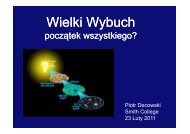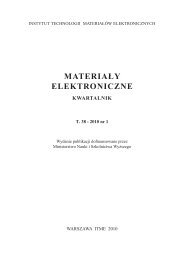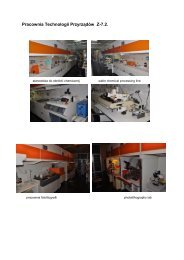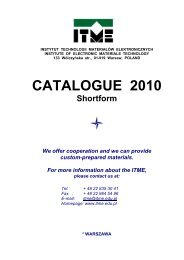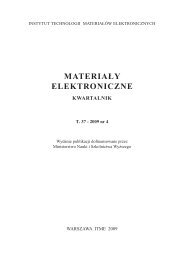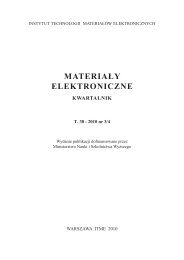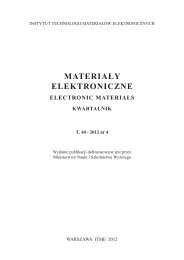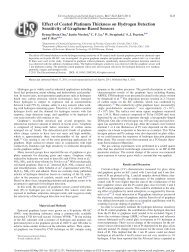Nr 1 - ITME
Nr 1 - ITME
Nr 1 - ITME
You also want an ePaper? Increase the reach of your titles
YUMPU automatically turns print PDFs into web optimized ePapers that Google loves.
Influence of stencil design and parameters of printing process...<br />
In the solder paste printing process, defects typically are caused by poor alignment<br />
between the substrate and stencil, incorrect material selection (substrate, paste type<br />
and stencil design) or variations in the amount of paste deposited [1].<br />
The stencil thickness, stencil material and stencil forming technique as well as<br />
size and shape of stencil apertures are fundamental factors which influence on the<br />
quality of printing process and reliability of solder joints. Higher melting temperatures,<br />
worse wettability of lead-free solders, smaller dimensions of pads and smaller<br />
distance between components are the main reason that optimization of these factors<br />
plays the crucial role in assembly of fine pitch devices and creation of high quality<br />
solder joints.<br />
Many industrial and research centers make the investigations on the selection<br />
of shapes and dimensions of apertures for lead-free soldering of fine pitch devices.<br />
However, the results of these investigations are often contradictory. Many of these<br />
elaborations should be examined in “real-life” large scale production. Usually changing<br />
of shape and apertures dimensions is made in order to minimize of soldering<br />
defects such as formation of solder balls under component (the characteristic defect<br />
for R/C components), tombstoning, solder bridges, solder deficiencies, and excessive<br />
quantity of voids (BGA, CSP components) [2, 3].<br />
2. BASIC PARAMETERS OF STENCIL DESIGN AND PRINTING<br />
PROCESS<br />
Volume of solder paste transfered through stencil aperture is characterized by the<br />
geometrical parameters, such as aspect ratio, area ratio and transfer efficiency.<br />
Aspect Ratio – The aspect ratio is the ratio of the aperture opening to the stencil<br />
thickness (eq. 1). For chemically etched stencils, this ratio should be greater than<br />
1.5, for laser cut stencils it should be greater than 1.2 and for electroformed stencils<br />
which has the best solder paste release characteristics this ratio should be greater<br />
than 1.1. Anything less than these recommended ratios can cause the solder paste<br />
stick excessively to the walls of the aperture during release as the retaining force<br />
of the paste in the aperture will be stronger than the force pulling the paste out of<br />
the aperture [1, 4].<br />
74<br />
ASPECT RATIO =<br />
D NA<br />
where: D NA<br />
– narrowest aperture dimension, T – stencil thickness.<br />
Area Ratio – It is the relation between the surface of the aperture and the inside<br />
surface of the aperture walls (eq. 2). The major different with aspect ratio is that the<br />
area ratio is more suitable for shapes such as circles. Since solder paste has a certain<br />
T<br />
(1)




